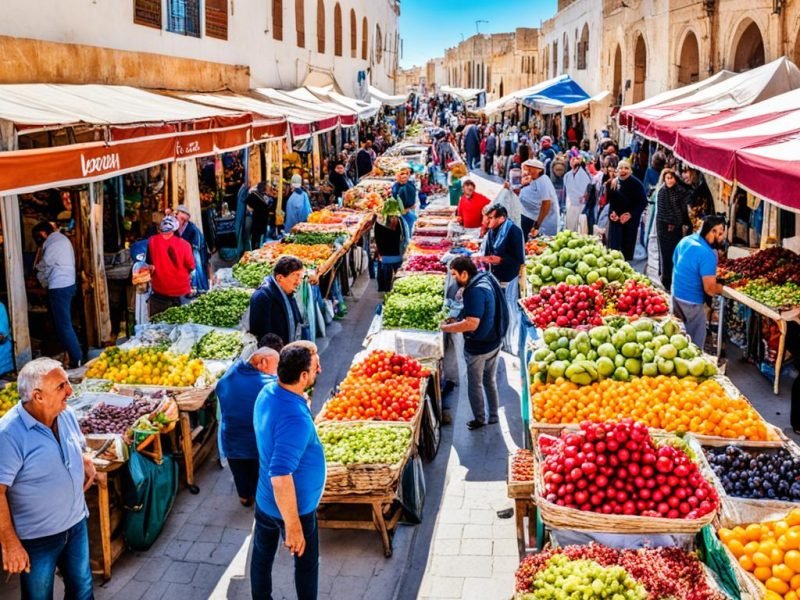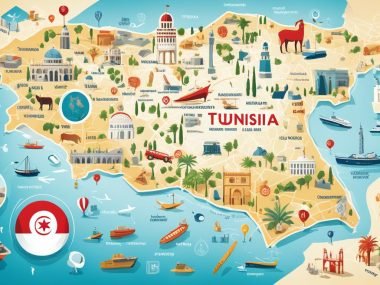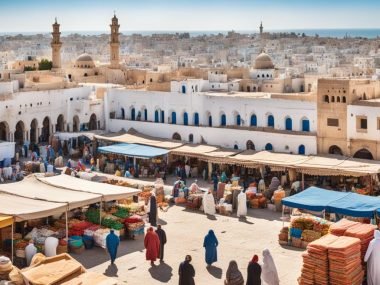The Quality of Life Index in Tunisia is at 115.17. Tunisians contribute to this score, showing us their way of life and happiness. Yet, we need more info for true accuracy. This data includes inputs from cities all over Tunisia, with updates until May 2024. It’s important that more people help with this data for better reliability. Knowing about Tunisia’s lifestyle, happiness, and wellbeing is key to understanding how good life is there.
Key Takeaways
- The Quality of Life Index for Tunisia is 115.17.
- The data is contributed by Tunisian citizens and updated till May 2024.
- There is a need for more contributors to improve data precision.
- Insights reflect the overall lifestyle, wellbeing, and standard of living in Tunisia.
- Understanding Tunisia’s happiness index is essential for grasping the broader context of the quality of life.
Economic Factors Affecting Quality of Life in Tunisia
The economic situation in Tunisia greatly affects its people’s quality of life. Employment rates, growth in GDP, and efforts to decrease poverty are key. They shape the everyday life and future for the citizens of Tunisia.
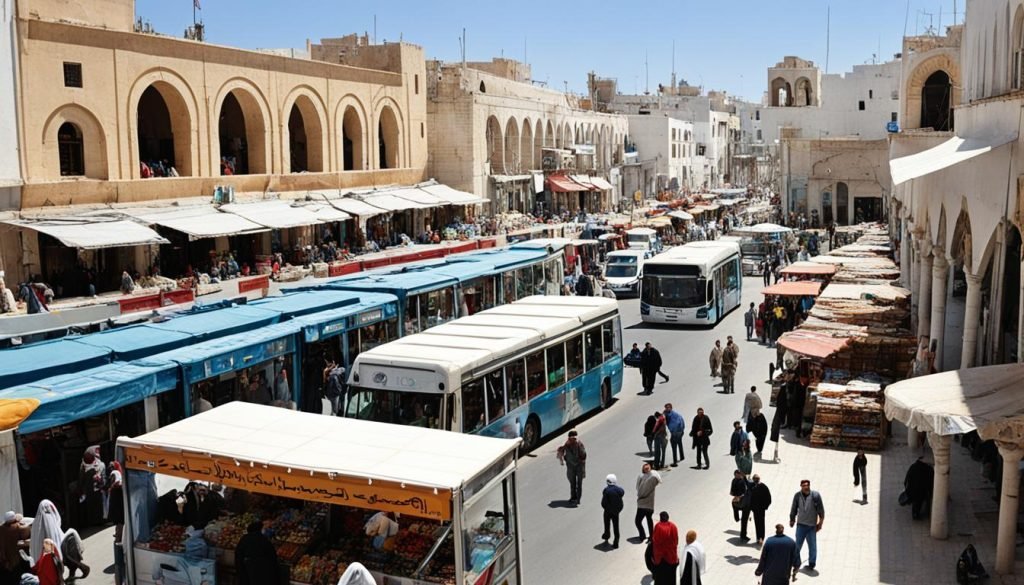
Employment and Unemployment Rates
The unemployment rates in Tunisia are worryingly high, especially among young people and women. The rates have gone higher than 30%. Between 2005 and 2018, unemployment was at an average of 15.36%. It reached its highest at 18.90% in 2011. Creating more jobs in the formal private sector is essential to improve this situation.
GDP Growth and Decline
The path of GDP growth in Tunisia has had ups and downs. From USD 21.47 billion in 2000, it rose to USD 47.59 billion in 2014. Afterwards, it dropped to USD 40.25 billion in 2017. Changes in GDP directly impact economic opportunities and stability, crucial for a better life in Tunisia.
Poverty Reduction Progress
There’s been significant progress in reducing poverty in Tunisia. The rate fell from 25% in 2000 to 15% by 2015. Extreme poverty has also greatly decreased. These successes show how effective policies and initiatives can uplift many Tunisians’ lives.
| Year | Unemployment Rate | GDP (in USD Billion) | Poverty Rate |
|---|---|---|---|
| 2000 | 14.0% | 21.47 | 25% |
| 2007 | 12.80% | 35.20 | 18% |
| 2011 | 18.90% | 45.00 | 17% |
| 2014 | 16.2% | 47.59 | 15% |
| 2017 | 15.3% | 40.25 | 15% |
Living Standards in Tunisia
In Tunisia, people are facing changes in how well they live because of the economy. The government is trying to help by making things more stable. Their actions are vital in these uncertain times.
Getting a home you can afford is really tough for many in Tunisia. Things cost more and getting a loan is hard. But, the government is helping out with money support. This aid is to make housing more affordable as part of fighting poverty.
Affordability of Housing
Housing affordability greatly affects how people live in Tunisia. Even with government help, many find it hard to afford homes. Inflation and hard-to-get loans are big problems. But subsidies are helping families afford places to live. Yet, there’s still much to do to make housing affordable for everyone.
Availability of Microfinance
Microfinance in Tunisia plays a big role. It helps people who can’t get regular bank loans. They can start businesses or invest. But, it’s not easy for everyone to get these services. Making microfinance more available can help more people get homes. It can also boost the economy in places that need help.
Health Care System in Tunisia
Tunisia’s health care system aims to keep its people healthy. The Ministry of Health oversees it, covering all care levels. These levels include clinics and hospitals all the way to specialist centres.
Public Health Care Structure
In Tunisia, the public sector leads health care, holding most hospital beds. It is crucial for offering medical services to everyone. By linking different health facilities, the goal is to provide smooth and effective care.
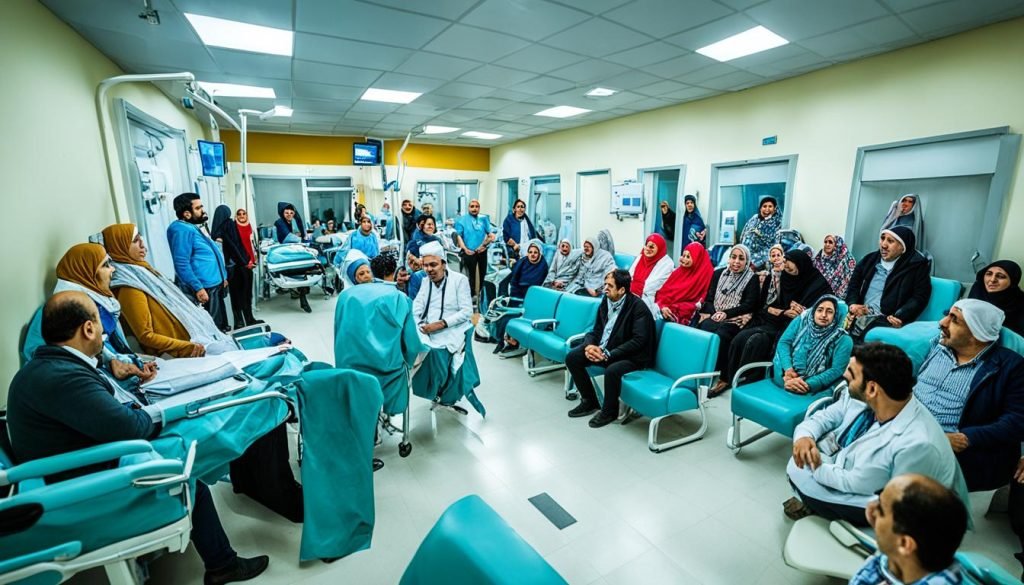
Movement Towards Universal Health Care
Tunisia is moving towards universal health care with great strides. Led by the National Health Insurance Fund, efforts increase health service access for all. This shows a dedication to reducing health inequities and improving nationwide health fairness.
Health Care Spending
Health care spending in Tunisia is significant, showing the country’s dedication to health. In 2013, the nation spent 7.1% of its GDP on health. This funding supports the vision of universal care, ensuring a strong system for quality care for everyone.
| Year | GDP (USD Billion) | Health Care Spending (% of GDP) |
|---|---|---|
| 2000 | 21.47 | 6.5% |
| 2013 | 47.59 | 7.1% |
| 2017 | 40.25 | 6.9% |
Education and Human Development
The education system in Tunisia plays a key role in its growth plan. After the 2011 revolution, there was a big push to improve the education system. The Strategic Plan for the Education Sector 2016-2020 aims to raise education standards.
Primary education is free and compulsory. It ensures that young Tunisians get a strong start in life. The reforms also cover secondary and higher education, aiming to build a strong workforce.
There is now more focus on making the curriculum relevant today and including new technology. They are also improving educational buildings and resources. This helps both students and teachers.
Working with the private sector is encouraged. This partnership brings in new ideas and extra money. These steps help improve Tunisia’s human development and quality of life index.
Here’s how some important education figures changed after the plan:
| Indicator | Before 2016 | After 2020 |
|---|---|---|
| Primary School Enrolment | 98% | 99.5% |
| Secondary School Completion | 65% | 75% |
| Higher Education Participation | 32% | 45% |
Conclusion
Reflecting on Tunisia’s life quality shows an interesting view. The quality of Life Index is at 115.17, showing strengths and weaknesses. Tunisia thrives in healthcare, education, and economic stability. Yet, issues like youth unemployment and housing prices need attention.
Tunisia’s economy has grown over the years, showing strength and potential. From a peak GDP of USD 47.59 billion in 2014 to a dip, it highlights the need for inclusive growth. The drop in poverty from 25% in 2000 to 15% by 2015 brings Tunisia closer to stability.
Tunisia is improving its healthcare system with more coverage. Steps toward universal healthcare show progress, needing more investment. In education, reforms post-2011 focus on quality and access. The challenges are many, but there’s hope for a better life quality. By tackling problems and playing to its strengths, Tunisia can move towards a brighter future.

